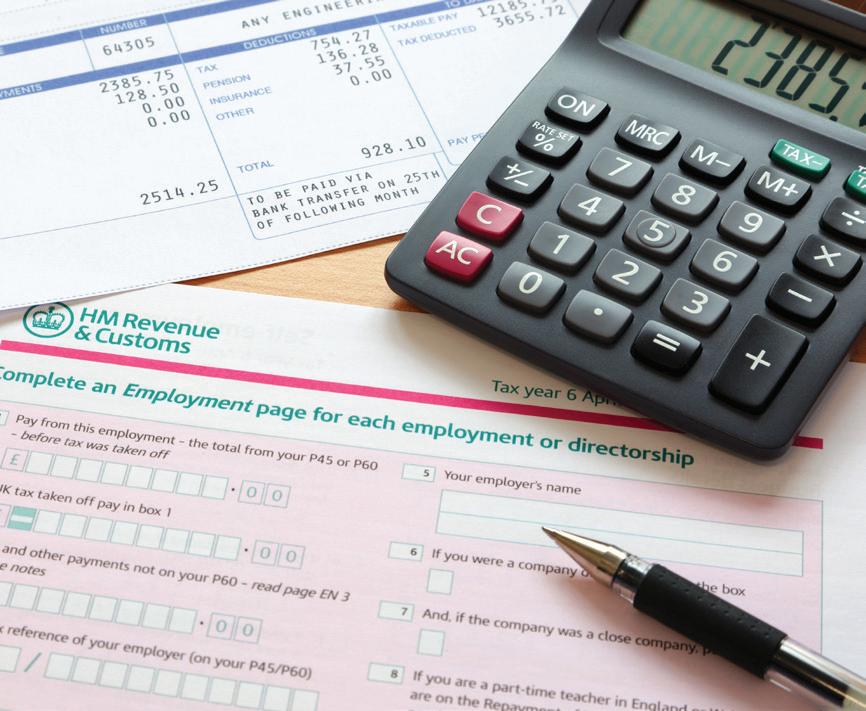
4 minute read
Action planning for the tax year end
ACTION PLANNING
FOR THE TAX YEAR END
Stuart Noakes, Head of Tax at MHA Carpenter Box, offers some food for thought as the end of tax year quickly approaches

New Year’s Day may seem eons ago, but now is as good a time as ever to stop, reflect and ensure you’re taking full advantage of the tax opportunities around you.
It’s certainly a good time to start planning your tax affairs so you can make the most of your money before the end of the tax year on April 5th (or March 31st for companies). We’ve outlined below a few ideas and action points to get you started.
1INCOME TAX
YOUR STARTING POINT
The starting point in tax planning is to understand where your income is likely to fall relative to the tax thresholds. For 2020/21, the tax-free personal allowance is £12,500 and the next £37,500 is taxed at the basic rate of 20% (7.5% for dividend income).
Higher rate tax of 40% (32.5% for dividends) is charged on income above £50,000 and additional rate tax of 45% (38.1% for dividends) is charged on income above £150,000. Note that dividends are treated as the top slice of income, so the basic and higher rates are first allocated against other income. The personal allowance is reduced by £1 for every £2 of income above £100,000. There is therefore no personal allowance at all where income exceeds £125,000. This also means that, over the income band £100,000 to £125,000 the effective rate of income tax is 60%.
Action point: Personal pension contributions provide some of the highest rates of income tax relief, and with it being suggested that pensions tax relief could be restricted, this is an excellent time to make additional contributions if you are able to. For example, if your income is in the band £100,000 to £125,000 a gross pension contribution of £10,000 could cost as little as £4,000 after tax reliefs.
2PENSION PLANNING
TAKE ADVANTAGE OF THE EXCELLENT TAX RELIEF
For most taxpayers, the maximum pension contribution is £40,000 each tax year, although this depends on your earnings. This limit covers both contributions by the individual and their employer. The unused allowance for a particular tax year may be carried forward for three years and can be added to the relief for the current, but then lapses if unused.
Although funds invested within a pension can grow tax free, there is a limit (the lifetime allowance – LTA) on the total amount you can hold in a pension pot: funds in excess of the limit will suffer penalty tax charges when you start to take pension benefits.
The LTA reduced from £1.25m to £1m from April 6th 2016. The Government announced that the LTA will increase in line with the consumer price index each year from April 6th 2018. Therefore, from April 6th 2020 for the tax year 2020/21, the LTA increased to £1,073,100.
Action point: If the total of all your pension funds is likely to be at or near £1m by the time you retire, you should seek urgent advice.
3TAX FAVOURED INVESTMENTS
ISAs CAN MAKE A BIG DIFFERENCE
Individual Savings Accounts (ISAs) are an excellent investment for higher rate taxpayers. The maximum annual allowance is £20,000. You must save or invest by April 5th for it to count for that year and if you don’t use the allowance it is lost.
The ISA family has grown considerably since its inauguration in 1999, with a further five ISAs to consider: n Help to Buy (HTB): First-time buyers get a 25% cash bonus from the
Government on savings made into a
HTB ISA. HTB ISAs are now closed to new accounts, although already opened accounts can continue until
November 2029. n Inheritance ISA: This allows a spouse or civil partner to inherit the savings in an ISA belonging to their deceased loved one without triggering income tax. n Lifetime ISA (LISA): UK residents aged 18-39 can contribute up to £4,000 per tax year, and the
Government will add a 25% bonus at the end of each tax year in respect to contributions paid. n Flexible ISA: This is a basic ISA which allows you to withdraw and replace money from your ISA. n Innovative Finance ISA (IFISA): An
IFISA lets you put your savings with peer-to-peer lenders or invest in companies through crowd funding websites.
Action point: Prudent utilisation of the reliefs associated with tax favoured investments as part of a balanced portfolio can make a big difference to future investments’ returns, but it is important to consider the risks associated with them and it is essential that professional advice is sought.
DOWNLOAD OUR YEAR END TAX PLANNING GUIDE

Our national tax team at MHA has worked together to create a handy Year End Tax Planning Guide. It applies to both individuals and companies, and summarises key tax and financial planning tips, including more information on the points above.
You can download your free copy at: www.carpenterbox.com/ tax-planning-guide
As always, each individual’s circumstances will be different, so a personal review should always be undertaken to ensure that the most suitable strategy is followed. For further advice on any of these topics, our tax advisory service can help you. Please call Stuart Noakes on 01903 234094 or visit www.carpenterbox.com.











